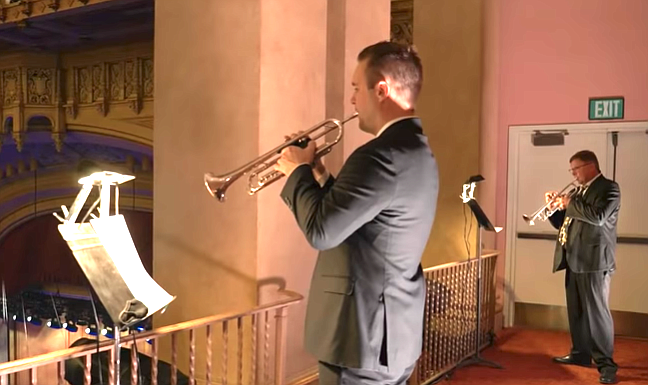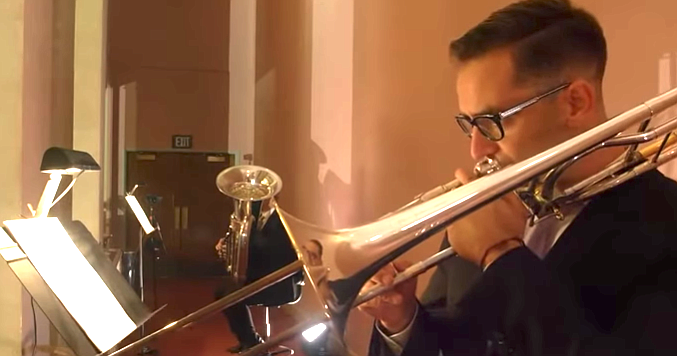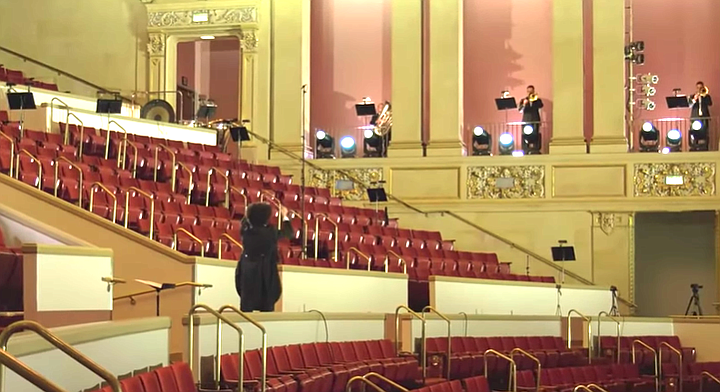 Facebook
Facebook
 X
X
 Instagram
Instagram
 TikTok
TikTok
 Youtube
Youtube

The San Diego Symphony streamed their second concert on Friday, November 20. This concert was performed in Symphony Hall. It is available in its entirety on YouTube.
This is exactly the type of concert the San Diego Symphony needs to be doing via streaming. I’m not sure how the attendance would have been based on the repertoire but online, attendance isn’t an issue. Views are nice to have online and a concert such as this one is going to do well.
All three sections of the orchestra, brass, strings, and winds had their own sections of the concert as the entire orchestra performed a little-known symphony from the French Classical Period.
The program started with brass pieces from the Baroque. I would have loved to have been able to attend this concert and experience the solemn grandeur of Giovanni Gabrieli’s Sonata pian’e forte (Loud and Soft Sonata) with the brass split right and left. For Giovanni Battista Buonamente’s Sonata from Sonatas and Conzones, Book 6, the brass was positioned throughout the house.
The effect in the hall must have been magnificent. Baroque music is under-represented in the concert offerings of most civic orchestras. The Baroque is often the territory of smaller specialized ensembles. I, for one, love Baroque music played on modern instruments and these two opening pieces were brilliant.

Following the Baroque was the Classical period in the form of Symphony No. 1 by Chevalier St. Georges. This was a timely inclusion and shows that the symphony has the ability to stay up to date with current trends in the broader classical music world.
St. Georges has been getting some press of late. He was educated in Paris but had been born in the French colony of Guadaloupe. His father was French and his mother was an African slave.

St. Georges was adept at several skills including violin and fencing. He was as the commander of a legion during the French Revolution. As was usually the case, the Revolution swallowed him up, and he spent 18 months in prison for non-revolutionary activities such as concertizing.
His Symphony No. 1 is delightful and was well performed by the socially distanced orchestra. The San Diego Symphony is continuing to play idiomatically in the classical style under music director Rafael Payare.

The next piece was by Venezuelan composer Aldemaro Romero entitled Fuga con pajarillo from Suite for Strings No. 1. I enjoyed this energetic music and even went back and listened to it a second time.
The concert finale was Dvorak’s Serenade in D minor, Opus 44. The serenade was performed by the symphony’s wind section. What can I say? Dvorak was a master and this music has that charming touch of melancholy that we all love about the Czech composer.
These first two concerts have been exceptional not just in the performances but also in the repertoire chosen. It is encouraging to see and hear the symphony continuing to influence the musical life of San Diego and beyond.


The San Diego Symphony streamed their second concert on Friday, November 20. This concert was performed in Symphony Hall. It is available in its entirety on YouTube.
This is exactly the type of concert the San Diego Symphony needs to be doing via streaming. I’m not sure how the attendance would have been based on the repertoire but online, attendance isn’t an issue. Views are nice to have online and a concert such as this one is going to do well.
All three sections of the orchestra, brass, strings, and winds had their own sections of the concert as the entire orchestra performed a little-known symphony from the French Classical Period.
The program started with brass pieces from the Baroque. I would have loved to have been able to attend this concert and experience the solemn grandeur of Giovanni Gabrieli’s Sonata pian’e forte (Loud and Soft Sonata) with the brass split right and left. For Giovanni Battista Buonamente’s Sonata from Sonatas and Conzones, Book 6, the brass was positioned throughout the house.
The effect in the hall must have been magnificent. Baroque music is under-represented in the concert offerings of most civic orchestras. The Baroque is often the territory of smaller specialized ensembles. I, for one, love Baroque music played on modern instruments and these two opening pieces were brilliant.

Following the Baroque was the Classical period in the form of Symphony No. 1 by Chevalier St. Georges. This was a timely inclusion and shows that the symphony has the ability to stay up to date with current trends in the broader classical music world.
St. Georges has been getting some press of late. He was educated in Paris but had been born in the French colony of Guadaloupe. His father was French and his mother was an African slave.

St. Georges was adept at several skills including violin and fencing. He was as the commander of a legion during the French Revolution. As was usually the case, the Revolution swallowed him up, and he spent 18 months in prison for non-revolutionary activities such as concertizing.
His Symphony No. 1 is delightful and was well performed by the socially distanced orchestra. The San Diego Symphony is continuing to play idiomatically in the classical style under music director Rafael Payare.

The next piece was by Venezuelan composer Aldemaro Romero entitled Fuga con pajarillo from Suite for Strings No. 1. I enjoyed this energetic music and even went back and listened to it a second time.
The concert finale was Dvorak’s Serenade in D minor, Opus 44. The serenade was performed by the symphony’s wind section. What can I say? Dvorak was a master and this music has that charming touch of melancholy that we all love about the Czech composer.
These first two concerts have been exceptional not just in the performances but also in the repertoire chosen. It is encouraging to see and hear the symphony continuing to influence the musical life of San Diego and beyond.
Comments